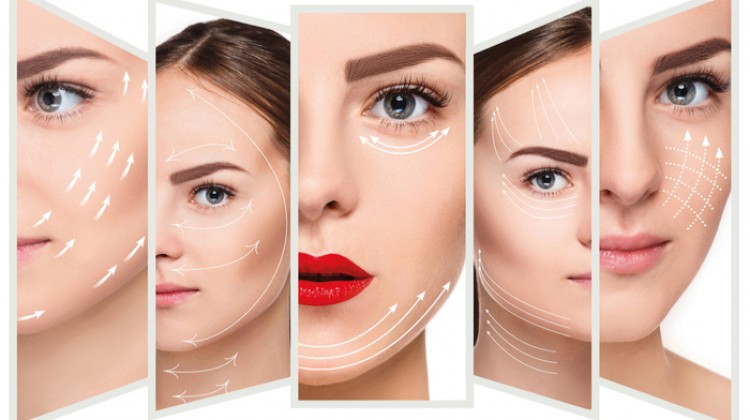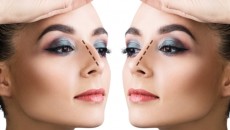Face Aesthetic

Face Lift
Aging changes in the face do not occur suddenly they evolve slowly and involve different regions of the face at different stages. Improving appearance surgically often requires a series of planned operations designed to forestall the inevitable signs of aging rather than one major all-encompassing operation. For example, the earliest signs of aging generally become apparent around the eyes as the eyelids become baggy, “crow` s feet” form, and upper eyelid skin and eyebrows tend to sag. When adequate rest no longer diminishes these changes, the time has arrived for correction of baggy eyelids and drooping brows often the initial operation necessary to improve appearance in an aging face. In some families these changes become troublesome in the mid-twenties or early thirties.
Aging changes in the face proper generally occur later as elastic tissue decreases and facial bones ant! skull actually thin and become smaller. The overlying skin “envelope” thereby becomes excessive and creates skin and muscle sagging and pouching along the jawline (“jowls”), under the chin, and at the corners of the mouth. Gravity exaggerates these changes and leads to a “tired” look when the patient actually feels vigorous and healthy. Not generally appreciated are the aging changes that develop in the nose; it tends to become sharper, less well defined and actually longer in relation to other facial features. Lifting and conservatively sculpturing the drooping nose is one of the most effective of operations to improve appearance.
Currently patients no longer need to wait until hanging folds or almost irreversible changes of aging have occurred to seek improvement; improved operations have shifted preference for corrections to the early forties (or earlier in some circumstances), when planned limited corrections can often be made to maintain a youthful appearance for an extended time. The final surgical results are almost always better when aging skin problems are corrected at an earlier age. Increasing numbers of men as well as women are experiencing the benefits of a facelift; as the general population ages, many older individuals who continue to work and enjoy good health wish to look as good as they can by diminishing the signs of aging.

The facelift operation is designed to improve the various areas of loose, sagging skin and muscle folds of the face and neck that are a consequence of aging. Facelift operations have several variations in design, depending upon the anatomy and degree of aging in individual patients. The skin, muscle, and fatty tissues of the face and neck are elevated and tightened to result in an improved appearance. Incisions may vary slightly from patient to patient in order to best correct the most prominent deformities.
Commonly other surgical procedures are combined with a facelift to correct specific aging problems (eyelid surgery, forehead lift, midface lift, double chin removal, etc.). Increasingly, older patients are benefiting from correction of the aging nose (rhinoplasty) since one of the effects of aging may involve an elongation and drooping of the nose and lead to an interference with breathing.
Naturally, everyone contemplating the operation is interested in how much improvement they can expect and for what duration the improvement will be apparent. The amount of improvement depends upon the degree of wrinkling present and the patient`s predetermined genetic predisposition. If it is marked, results may be dramatic. If sagging is early and the operation is being done to attempt to keep the patient looking young, the improvement may be more subtle remarks will be made that the face looks less tired and more “alive.”
The duration of improvement cannot be accurately predicted in all cases. If wrinkling is severe, it will obviously take a longer time after surgery for the condition to become as bad as it was before surgery. If the degenerative process of the skin is very rapid, the wrinkling and sagging will occur more rapidly. In a face that is simply fat, it will be improved for only a short time. In ideal cases, however, the duration of improvement is often from 5 to 10 years. No operation can permanently prevent aging, but the individual can expect to appear younger than if the operation had not been performed.
The operation is usually performed under general anesthesia. Following surgery, a small thin tube may be placed in the back of the ear to allow drainage of any blood collecting under the skin. Large loose dressings will be applied to the face and neck. The patient is generally discharged the day after surgery with the removal of the drains. After surgery, there is some pain that is easily controlled by medication. The patient will be asked to keep her/his head slightly elevated for a few days. Dressings commonly are removed in a few days.
The stiches are removed on 5-7 days. Swellings and skin discoloration are common and usually will subside within a week or two. Using cosmetics is permitted after the sutures have been removed. Exposure to the sun should be limited for a few months followings surgery and accompanied by a sun screen with a high protection factor.
Many patients report a sense of tightness or numbeness of the face and neck after surgery. The intensity of these conditions and how long they will last varies with the individual.
At approximately 1 week from the date of surgery, generally patients are able to return to normal activities such as work. Strenuous sports, exercises, swimming, or other physical activities should be curtailed for approximately 3 to 4 additional weeks. The patients are advised not to take aspirin it may precipitate bleeding.
The following facts related to the facelift operation specifically and the aging process in general should be understood:
A satisfactory facelift performed by an experienced surgeon is a major operative procedure that requires 2 or 3 hours of surgery. So called mini facelift procedures generally result in only a “mini” effect and have little or no lasting value.
Facial creams, cosmetics, muscle exercise, and chin supports all have little or no effect on the aging process and cannot be substitute for a needed facelift where facial sagging and pour muscle tone exist.
The incisions required for a facelift, meticulously camouflaged in preexisting wrinkles and within the hairline, are generally inapparent shortly after surgery.
Some patients will experience a variable degree of bruising and discoloration in the face and neck following surgery that generally subsides in 1 to 3 weeks. Ordinarily there is surprisingly little discomfort associated with facelift surgery.
A temporary numbness in and around the facelift incisions and ears is normal; sensation returns gradually within several weeks.
Finally, it should be understood that the facelift operation will not eliminate the small vertical creases about the lips, bulging or excess skin about the eyelids, or horizontal creases of the forehead these disfigurements require separate procedures that may be combined with the facelift.
Secondary Facelift Procedures
Often after a facelift a secondary procedure may be performed on individuals whose tissues are particularly prone to sag again. Usually the “tuck-up” is not necessary for 1 to several years following an adequate initial facelift, but with patients who are overweight, have heavy faces, or have waited until wrinkling or sagging are extreme prior to the lift, the “tuck-up” may be beneficial if performed earlier and give a more lasting result. This type of less extensive facelift requires much less surgery than the initial procedure and is often done as an out patient surgical procedure. The incisions and scars are in the same general areas and are camouflaged as in the initial operation, but the recovery period is much shorter, and discoloration and swelling are minimal.










